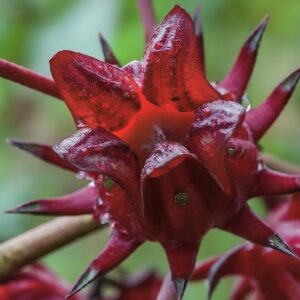Hibiscus Sabdariffa


An amazing journey
For over 6,000 years, Hibiscus sabdariffa has been a vibrant thread woven into the tapestry of human nutrition. Its calyxes, the fleshy base of the flower, brim with vitamins and essential minerals. Early civilizations in Africa discovered its rich content of sustaining nutrients that provide natural defense against illness. But roselle offers more than just basic sustenance. It holds a bounty of powerful phytochemicals – natural plant compounds with a surprising range of health benefits. These include anthocyanins, the pigments that give roselle its ruby-red hue, and flavonoids, both offering potent antioxidant properties that fight free radicals and reduce the risk of chronic diseases. With every sip of roselle tea, we harness this remarkable plant’s gifts, consuming a powerful blend of essential nutrients and health-promoting compounds.
This website provides the world’s largest cache of information about Hibiscus sabdariffa and its many fascinating properties and benefits.
Join us on an amazing journey into the world of Hibiscus sabdariffa!
Learn more about Hibiscus sabdariffa…

Discover the wealth of research on Hibiscus sabdariffa
What are the standards for Hibiscus sabdariffa?
Discover the world of Hibiscus sabdarrifa products
A world of resources for Hibiscus sabdariffa
Get the latest intel in the world of Hibiscus sabdariffa

History of Hibiscus sabdarrifa
Discover the rich history of Hibiscus sabdariffa?

The biochemistry of Hibiscus sabdariffa
Hibiscus sabdarrifa presents a powerhouse of beneficial phytochemicals.

Some of the healthiest products in the world feature Hibiscus sabdariffa
Here is a showcase of products featuring the full benefits of Hibiscus sabdariffa.
FAQS
Facts are facts until they are disproven.
This website strives to present the most accurate information available.
If we don’t have the facts straight for any reason, let us know!
Where did Hibiscus sabdariffa originate?
The hibiscus species, Hibiscus sabdariffa, is probably of tropical African origin and may have been domesticated as early as 4000 BC in Sudan. (Reference)
European claims of “discovering” this plant are inaccurate. While Carl Linnaeus, a Swedish botanist, formally described it in 1753, the plant was already known and cultivated elsewhere. The spread of Hibiscus sabdariffa around the world happened through various means, including the movement of enslaved people from Africa. Because the plant was established in many regions well before the 18th century, crediting Europeans with its discovery disregards the long history of cultivation by indigenous peoples around the globe.
Hibiscus sabdariffa has been named by many cultures. The nomenclature used by traditional cultures is listed here.
What are the common names for Hibiscus sabdariffa?
Hibiscus sabdariffa has a global presence, reflected in the vast array of names it holds across different countries. Here’s a brief glimpse into some of the most common names by region (there are many more!):
Africa:
- West Africa: Bissap (Senegal, Gambia), Karkadé (Mali, Burkina Faso), Sobolo (Ghana)
- North Africa: Karkadeh (Egypt, Sudan)
- East Africa: Mbuyu (Kenya), Busaa (Ethiopia)
Latin America:
- Mexico and Central America: Flor de Jamaica (Jamaica Flower), Agua de Jamaica (Jamaica Water)
Caribbean:
- Sorrel (Jamaica, Trinidad and Tobago)
Asia:
- India: Lal Patta (Red Leaf), Gongura (Telugu)
- Southeast Asia: Roselle (English name commonly used), Rosella Teh (Indonesia)
- West Asia: Karkade (similar to North Africa)
Europe:
- Roselle (English name commonly used), Bissap (French, reflecting West African influence)
United States:
- Florida Cranberry
What does Hibiscus sabdariffa tast like?
Hibiscus sabdariffa, most commonly consumed as hibiscus tea, boasts a unique and refreshing flavor profile. Here’s a breakdown of what you can expect:
- Tartness: The most prominent taste characteristic is tartness, often compared to cranberry juice or rhubarb. This comes from the organic acids naturally present in the calyces (the fleshy red part of the flower) used to make the tea.
- Fruity Notes: Hibiscus tea often has subtle fruity undertones, sometimes described as resembling berries like hibiscus or blackcurrants.
- Tanginess: A slight tanginess complements the tartness, adding a refreshing dimension to the flavor.
- Subtle Sweetness: Hibiscus tea can have a naturally light sweetness, but it’s not overly sweet. Many people enjoy it without added sugar.
Factors Affecting Taste:
- Preparation: The brewing method and steeping time can influence the taste. Stronger brews will be more tart, while weaker ones might be slightly sweeter.
- Sweeteners: Often, people add sugar, honey, or other sweeteners due to the tartness of Hibiscus sabdariffa.
- Variations: Hibiscus tea can be blended with other ingredients like ginger, mint, or lemon, adding complexity and different flavor notes.
Overall:
Hibiscus tea offers a refreshing and tart flavor experience. If you enjoy cranberry juice or other tart and slightly fruity beverages, you might find hibiscus tea delicious. It’s a versatile beverage that can be enjoyed hot or iced, with or without additional flavorings.
What are the botanical characteristics of Hibiscus sabdariffa?
Taxonomy
| Kingdom | Plantae | planta, vegetal, plants | |
| Subkingdom | Viridiplantae – green plants | ||
| Infrakingdom | Streptophyta – land plants | ||
| Superdivision | Embryophyta | ||
| Division | Tracheophyta – vascular plants | ||
| Subdivision | Spermatophytina – seed plants | ||
| Class | Magnoliopsida | ||
| Superorder | Rosanae | ||
| Order | Malvales | ||
| Family | Malvaceae – mallows, mauves | ||
| Genus | Hibiscus L. – rosemallow | ||
| Species | Hibiscus sabdariffa L. – roselle |
Botanical Description
Source: Hibiscus sabdariffa -Roselle. https://www.researchgate.net/publication/335516779_Hibiscus_sabdariffa_-Roselle [accessed Mar 08 2024].
Is Hibiscus sabdariffa a sustainable crop?
Hibiscus sabdariffa has the potential to be a sustainable crop, but there are factors to consider for its overall impact. Here’s a breakdown of its sustainability strengths and weaknesses:
Strengths:
- Drought Tolerance: Hibiscus sabdariffa thrives in warm climates with moderate rainfall. It can withstand periods of drought, making it suitable for cultivation in areas with limited water resources.
- Relatively Low Maintenance: The plant doesn’t require excessive amounts of fertilizer or pesticides compared to some other crops. This can benefit farmers with limited resources and reduce environmental impact from these inputs.
- Fast-Growing Annual: Hibiscus sabdariffa has a relatively short growing cycle (around 6 months), allowing for multiple harvests per year and potentially increasing overall yield.
- Soil Health: Some studies suggest the plant can improve soil quality by fixing nitrogen and reducing erosion. This can be beneficial for long-term agricultural sustainability.
- Multiple Uses: All parts of the plant have potential uses. The calyces are used for beverages and food products, while the leaves and fibers can be used for animal feed, compost, or even textiles. This minimizes waste and maximizes resource utilization.
Weaknesses:
- Water Usage: While drought tolerant, Hibiscus sabdariffa still requires water for growth. In regions with very limited water resources, efficient irrigation practices are crucial for sustainable cultivation.
- Soil Depletion: While potentially beneficial for soil health in some cases, continuous cultivation without proper nutrient management can deplete soil fertility over time. Crop rotation and proper soil management are essential.
- Processing and Waste Management: Depending on processing techniques, waste products from the plant (like stems and seeds) might require proper management to avoid environmental impact.
- Pesticide Use: Although generally low-maintenance, some farmers might resort to pesticides if pest outbreaks occur. Sustainable pest control methods are essential for minimizing environmental impact.
Overall:
Hibiscus sabdariffa has strong potential for sustainable cultivation, especially for low-income farmers in suitable climates. However, achieving true sustainability requires responsible practices such as water conservation, soil management, efficient processing techniques, and minimizing reliance on pesticides.
Additional factors to consider:
- Local context: Sustainability is location-specific. Water availability, soil type, and existing agricultural practices in a particular region will influence the overall sustainability of Hibiscus sabdariffa cultivation.
- Farming practices: The way farmers cultivate and manage the crop significantly impacts its environmental footprint. Sustainable practices like organic farming or integrated pest management can further enhance its sustainability.
By fostering knowledge sharing, promoting responsible farming techniques, and developing efficient processing methods, Hibiscus sabdariffa can become a valuable crop that contributes to a more sustainable agricultural future.
Can you eat Hibiscus sabdariffa?
Yes, you can eat certain parts of Hibiscus sabdariffa flowers, but with some important details:
- Edible Parts: The most commonly eaten part of the flower is the fleshy red calyx, the fleshy base surrounding the flower bud. This part is typically used to make hibiscus tea.
- Not the Petals: The delicate flower petals themselves are not generally eaten. They may have a slightly bitter taste and are more for visual appeal.
- Leaves: In some cultures, the young leaves of the Hibiscus sabdariffa plant are cooked and eaten like spinach. However, they may have a slightly slimy texture.
Things to Consider:
- Preparation: It’s best to remove the stamen and pistil (the central part of the flower) when consuming the calyces as they can be bitter. You can rinse the calyces before using them.
- Taste: The calyces have a tart flavor similar to the tea but might be slightly more fibrous.
- Culinary Uses: The calyces can be used in various dishes, such as jams, jellies, chutneys, or salads. They add a tart and colorful element to recipes.
Overall:
While the vibrant flowers of Hibiscus sabdariffa might be tempting, the edible parts are primarily the fleshy calyces. With proper preparation, they can be a delicious and versatile ingredient for various culinary creations. Remember, the delicate petals are generally not consumed.
 .
. 

